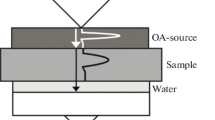Summary
With the aid of an ultrasonic pulse technique, the propagation of elastic waves (longitudinal as well as transverse) through polyurethane rubbers filled with different amounts of sodium chloride particles was studied. The velocity of both longitudinal and transverse waves was found to increase with filler content. From the measured wave velocities, the effective modulus for longitudinal waves,L, bulk modulus,K, and shear modulus,G, were calculated according to the relations for a homogeneous isotropic material. All three moduli appear to be monotonously increasing functions of the filler content over the whole experimentally accessible temperature range (−70 °C to + 70 °C forL andK;}-70 °C to about −20 °C forG) and they, moreover, reflect the glassrubber transition of the binder.Poisson's ratio,μ, was found to decrease with increasing filler content and show a rise at the high temperature side of the experimentally accessible temperature range (about −20 °C) as a result of the approach of the glass-rubber transition.
In addition to the velocities, the attenuation of both longitudinal and transverse waves was measured in the temperature ranges mentioned. It was found that in the hard region tan δL as well as tan δG are independent of the filler content within the accuracy of the measurements. In the rubbery region, however, tan δL, increases with increasing filler content.
Finally, the experimental data are compared with a simple macroscopic theory on the elastic properties of composite media.
Similar content being viewed by others
References
Schwarzl, F. R., H. W. Bree andC. J. Nederveen, Mechanical Properties of Highly Filled ElastomersI, Proc. 4th Int. Congr. on Rheol., Providence 1963,E. H. Lee (Ed.), Interscience/Wiley, New York (1965), Vol. 3, 241–263.
Van der Wal, C. W., H. W. Bree, F. R. Schwarzl, Mechanical Properties of Highly Filled ElastomersII, J. Appl. Polymer Sci.9, 2143–2166 (1965).
Waterman, H. A., Kolloid-Z.192, 1 (1963).
Waterman, H. A., S. S. Lanting andA. Oskamp, J. Sci. Instrum.42, 291–292 (1965).
van der Poel, C., Rheologica Acta1, 198 (1958).
Bruggeman, D. A. G., Ann. Phys. Lpz.24, 635 (1935).
Fröhlich, H., R. Sack, Proc. Roy. Soc. A185, 415 (1946).
Rose, F. E., Phys. Rev.49, 50 (1936).
Durand, M. A., Phys. Rev.50, 449 (1936).
Author information
Authors and Affiliations
Rights and permissions
About this article
Cite this article
Waterman, H.A. On the propagation of elastic waves through composite media. Rheol Acta 5, 140–148 (1966). https://doi.org/10.1007/BF01968495
Received:
Issue Date:
DOI: https://doi.org/10.1007/BF01968495




